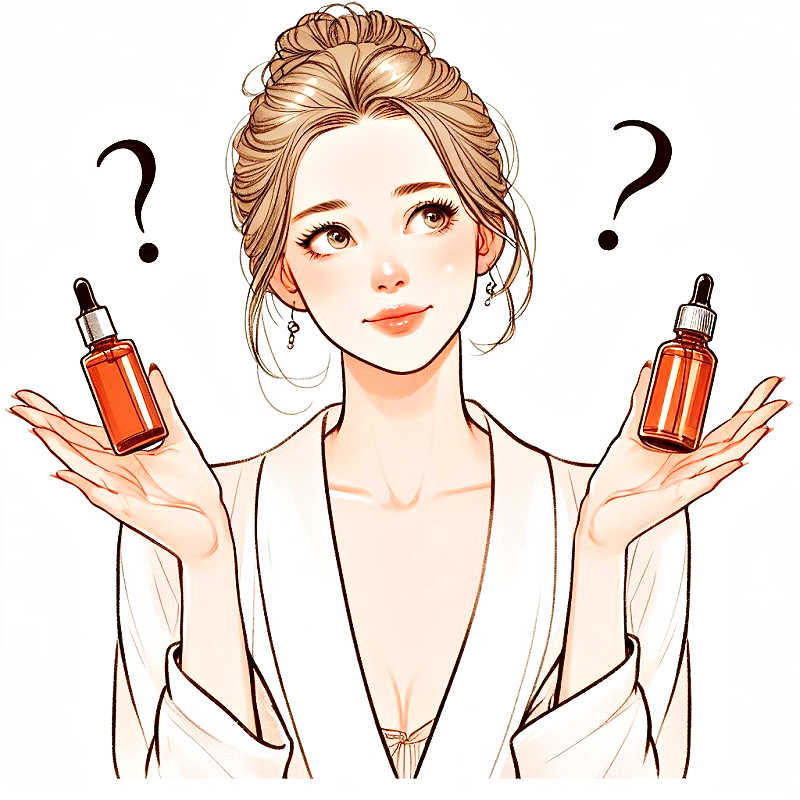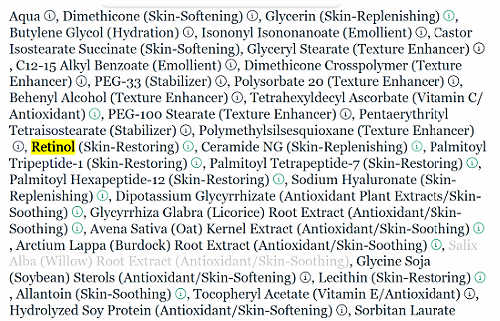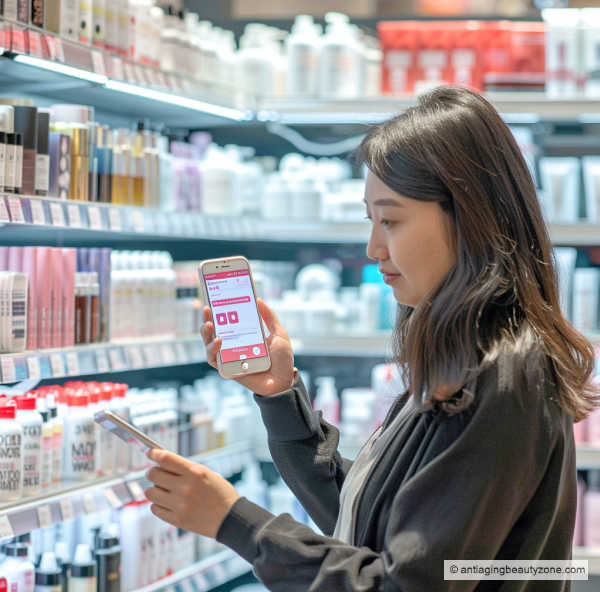the function and importance of ingredients found in beauty products
This anti-aging cosmetics guide will help you understand how beauty product ingredients work and why they matter for healthy looking skin.
Most anti-aging products have long lists of ingredients that read like a bunch of pseudo-scientific terminology.
But what do they do, and how can they help prevent or slow down skin aging?

We’ll break down:
- the purpose and action of the top popular anti-aging ingredients found in cosmetic products
- how to get the best bang for your buck
- which beauty product ingredients to avoid
your $$: Here’s what you should consider
Before splurging on that anti-aging wonder cream, check the label!
Cosmetic labels can be confusing with important sounding names that may not do anything at all. Or they maybe be full of ingredients harmful for your complexion.
Here’s the trick: look for the “active” anti-aging ingredient.
Why? It’s the superhero of anti-aging. The higher it is on the list, the stronger the product. In simple terms, more bang for your buck.
For instance, check out the ingredient list of this retinol skin repair serum by Paula’s Choice 1% Retinol Cream.
See how retinol is closer to the top than the bottom?
That means it contains a good amount of retinol, promising better results than products where it’s lower down on the list. 😊

Anti-aging cosmetic active ingredient list
Here is a list of the most popular active anti-aging ingredients that can help your skin look better.
For more detailed information, you can check them out at the INCI Decoder
- anti-wrinkle, exfoliates, promotes collagen
- super hydrator/moisturizer, skin firmer, anti-wrinkle
- skin-brightening and depigmenting properties.
- anti-inflammatory, wound healing & collagen production
- skin lightener, anti-wrinkle agent, stimulates collagen synthesis
- Improves skin elasticity, evens skin tone, and diminishes dullness.
- Protect the skin barrier, retain moisture, and improve skin texture.
- Prevents further aging caused by UV damage.
- Antioxidant, anti-inflammatory, and skin-soothing properties.
- Energizes skin cells, reduces the appearance of wrinkles, and has antioxidants.
beauty product ingredients to avoid

According to organizations such as the Environmental Working Group (EWG), Campaign for Safe Cosmetics, European Union (EU) Regulations, National Institutes of Health (NIH), and American Academy of Dermatology (AAD), when choosing beauty products, it’s crucial to avoid harmful and toxic ingredients:
- Parabens: Linked to hormone disruption
- Phthalates: Potential reproductive toxins
- Sulfates: Harsh detergents that can strip natural oils
- Formaldehyde: Known as a carcinogen and skin irritant
- Synthetic Fragrances: Often contain undisclosed allergens
- Triclosan: Can disrupt hormone function and contribute to antibiotic resistance
Opt for products free from these dangerous ingredients to promote healthier and safer skincare routines.
What to do now?
Yes, it’s overwhelming. You probably feel that you want or need to use all of them. Especially as we get older and find we’re dealing with more and more anti-aging skin issues.
Well, surprisingly, it’s not impossible to wind up using most of the anti-aging cosmetics discussed in the list above, since many products have dual actions and often contain multiple active ingredients.
And, in the course of a week (7 days), you could very possibly wind up using many of them through your normal combined skin care routines.
For example, at the very basic, most women over 40 follow a basic routine that includes the following:
- sensitive skin face wash
- super hydrating moisturizer
- anti-aging night-time cream or serum
- weekly exfoliator, peel, or facial
Don’t have a basic skin care routine yet? Not sure where to start? Click here for simple and affordable at-home solutions for skin over 40.
Finally – be patient
Be Patient
If you’re just starting to use anti-aging cosmetics, be patient.
Remember, just because certain cosmetic ingredients are clinically proven to help reduce the signs of aging – that does not guarantee that you’ll see the results you’re expecting.
No matter which anti-aging cosmetic product you choose, keep in mind that it could take 3-6 months to see improvements, such as a softer, smoother. or more hydrated appearance.
And, some people might exerprience temporary side-effects for the first few weeks.
Recommended
Under Eye Creams – How to find one with the “right” ingredients for your needs.
Sources:
Am J Clin Dermatol. 2010;11(2):95-102.Photoaging: prevention and topical treatments.
J Cosmet Dermatol. 2008 Dec;7(4):259-62. Clinical tolerance and efficacy of capryloyl salicylic acid peel compared to a glycolic acid peel in subjects with fine lines/wrinkles and hyperpigmented skin.
J Cosmet Laser Ther. 2013 Mar 6. [Epub ahead of print]. The anti-wrinkle efficacy of Argireline.
J Cosmet Laser Ther. 2013 Apr 22. [Epub ahead of print]. The anti wrinkle efficacy of synthetic hexapeptide (Argireline) in Chinese Subjects.
Am J Clin Dermatol. 2013 Apr;14(2):147-53. The anti-wrinkle efficacy of argireline, a synthetic hexapeptide, in Chinese subjects: a randomized, placebo-controlled study.
Acta Pol Pharm. 2012 Nov-Dec;69(6):1303-6. Effect of Gly-Gly-His, Gly-His-Lys and their copper complexes on TNF-alpha-dependent IL-6 secretion in normal human dermal fibroblasts.
J Pept Sci. 2012 Nov;18(11):685-90. doi: 10.1002/psc.2455. Epub 2012 Sep 28.Stem cell recovering effect of copper-free GHK in skin.
Mol Pharm. 2013 Mar 4;10(3):1063-9. Collagen stimulating effect of peptide amphiphile C16-KTTKS on human fibroblasts.
Clin Cosmet Investig Dermatol. 2013;6:43-9. doi: 10.2147/CCID.S39370. Epub 2013 Feb 12. Topical effects of N-acetyl-L-hydroxyproline on ceramide synthesis and alleviation of pruritus.
Int J Toxicol. 2005;24 Suppl 2:51-111. Final report of the safety assessment of L-Ascorbic Acid, Calcium Ascorbate, Magnesium Ascorbate, Magnesium Ascorbyl Phosphate, Sodium Ascorbate, and Sodium Ascorbyl Phosphate as used in cosmetics.
Mol Pharm. 2013 Mar 4;10(3):1063-9. doi: 10.1021/mp300549d. Epub 2013 Feb 4. Collagen stimulating effect of peptide amphiphile C16-KTTKS on human fibroblasts.
http://medceuticalsskincare.com/media/pdf/Matrixyl-3000.pdf
J Drugs Dermatol. 2013 May;12(5):533-40.Treatment of facial photodamage using a novel retinol formulation.
Arch Dermatol. 2007 May;143(5):606-12.Improvement of naturally aged skin with vitamin A (retinol).

